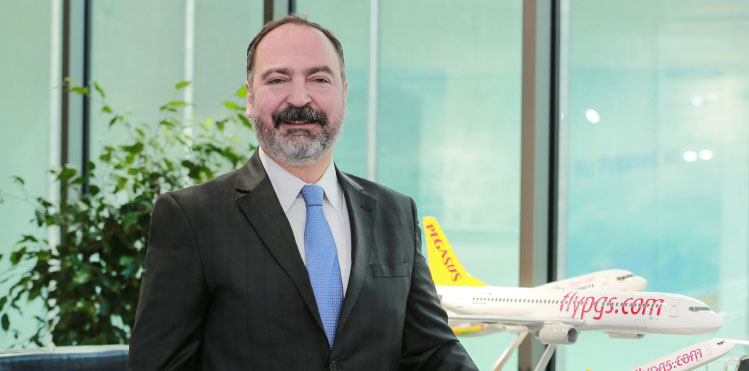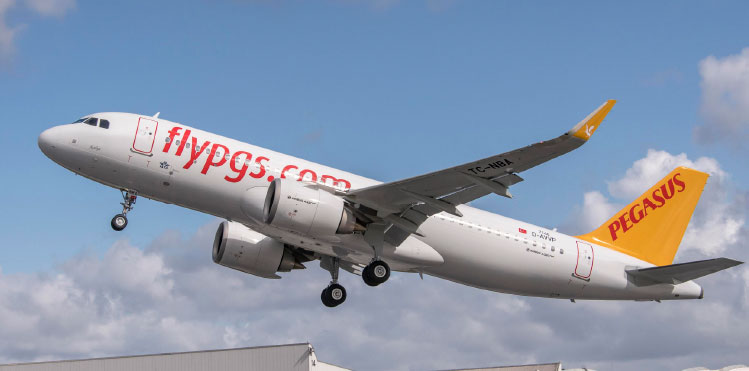Mehmet Nane, CEO Pegasus Airlines, interviewed by Ross Falconer.

Mehmet Nane, CEO Pegasus Airlines: “Our long-term ambitions are to continue to grow across our network, including boosting point-to-point flights between regional cities, as our position as a leading regional airline strengthens.”
Pegasus Airlines launched as a scheduled low-cost carrier in 2005 founded on the belief in “everyone’s right to fly”, and over 10 years has created a large and rapidly-expanding network achieving significantly above-market-average growth. Today, it serves 102 destinations in 40 countries: 33 in Turkey and 69 across Europe, Middle East, North Africa and Eurasia.
Mehmet Nane took over as CEO of Pegasus Airlines in March 2016. “We have come a long way and reached many important milestones in the company’s history, with many more to follow,” he tells Airport Business. “Since I started my position as CEO, we took delivery of the first order of 100 next-generation Airbus, becoming the first airline in the world to operate a CFM Leap-1A powered A320neo.”
Indeed, this new aircraft is the backbone of Pegasus’ ambitious expansion strategy. “Our priorities for 2016 are to focus on delivery of the rest of our Airbus A320neo aircraft, our transitioning to fully Pegasus operated ground handling operations which we completely took charge of earlier this year, and preparing the groundwork for our next phase of growth.”
Of course, it is a challenging time for Turkey, as is the case for the global travel industry and the world as a whole, but Nane speaks optimistically about the resilience of the region. “Istanbul is the heart of Turkish aviation, and the city is on the crossroads between Europe, Asia, Africa and the Middle East, which makes it a very significant hub for aviation,” he says. “Istanbul’s advantageous geographical positioning translates to a hugely growing transit business, and this is reflected in our strong transit guest numbers.”
In the first six months of 2016, Pegasus carried over 3.92 million transit guests – 2.17 million on international routes and 1.75 million on Turkish domestic routes. This means 28.93% of all guests carried on international routes were in transit, while the figure was 12.64% in transit on domestic routes.
“Furthermore, our strong large domestic market is what differentiates us from EU countries and keeps us resilient to the international market that has been heavily impacted by the challenging conditions of late,” Nane adds. “During such times of international market fluctuation, a strong domestic market acts as protection and our robust status as a key player in this market has kept us strong.”
Pegasus achieved 13.1% growth in passenger numbers on domestic routes between January and July 2016, carrying 8.61 million. Domestic traffic also accounted for almost 14 million out of its total of 22.3 million passengers in 2015.
In order to remain competitive in the LCC market, the airline constantly strives to innovate and transform. “We use technology to keep our competitive edge with our strong focus on investment and innovation: tech, fleet, customer relations, safety, training, and ramp services, for example,” Nane explains. “We are confident that the future holds positive developments for Turkey and the global tourism market. We anticipate improvements in the coming periods and a strong, stable, dynamic future returning.”
“The launch of an exciting new era”
The fleet is, of course, one of Pegasus’ most valuable assets, and it has one of Europe’s youngest fleets with 76 aircraft at an average age of 5.4 years. In July 2016 it received the first of 100 Airbus A320neo aircraft (75 confirmed orders and 25 options). It will take delivery of nine CFM-LEAP powered A320neos this year. “They represent the new face of Pegasus, marking the launch of an exciting new era for us, where we will be implementing our next stage of growth as a leading and pioneering regional player and low-cost carrier,” Nane enthuses. “In terms of our overall fleet strategy, we maintain good relationships with both Airbus and Boeing, and earlier this year made an order for five Boeing 737-800s to meet our aircraft demand in 2017 for this particular type of aircraft. However, our fleet strategy overall is to run one type of fleet – while currently a major part of our fleet comprises of Boeing aircraft, in 8-9 years’ time we plan for our whole fleet being Airbus.”

In July 2016 Pegasus received the first of 100 Airbus A320neo aircraft. “They represent the new face of Pegasus, marking the launch of an exciting new era for us, where we will be implementing our next stage of growth as a leading and pioneering regional player and low-cost carrier,” says Mehmet Nane, CEO Pegasus Airlines.
Pegasus recently added Iraq’s Sulaymaniyah and China’s Kashgar to its network, and earlier this year launched flights between Ankara and Amman, as well as flights between Istanbul and Gabala in Azerbaijan. Meanwhile, through its new codeshare partnership with Saudi Arabian airline Flynas, Pegasus now operates between Jeddah and Riyadh to Istanbul and five other Turkish cities with onward connections to other destinations in its network.
“Our strategy has been to expand our network and to add new destinations with our growing fleet of new aircraft,” Nane comments. “Our long-term ambitions are to continue to grow across our network, including boosting point-to-point flights between regional cities, as our position as a leading regional airline strengthens.”
Despite the challenges of 2016, Pegasus remains on target to surpass its 2015 passenger total of 22.3 million to reach over 24 million this year. Its biggest source of growth is the new markets it is penetrating in Russia, the Middle East, Africa, the Caucasus and Eastern Europe. “We will offer these new regions the combined advantages of the Pegasus model, including new aircraft, better on-time take-offs and affordable prices,” Nane says. “While the rise of LCCs worldwide has largely been based on point-to-point services, our additional growth potential arises from us being a hub between East and West, North to South, which allows us to unite continents and destinations many other low-costs don’t reach.”
Alongside network expansion, Pegasus is also focusing on increasing frequencies on some existing routes – for example, it now flies double-daily to Cologne, Düsseldorf, Frankfurt, London Stansted and Paris; 17 times weekly to Amsterdam; and 14 times weekly to Beirut. As fast as it can obtain traffic rights from the Civil Aviation Authority, Pegasus will continue to launch new routes, increase frequencies and maintain steady growth.
“Looking ahead, our mission for 2017 is focusing on the optimisation of our three key pillars to build a solid base for further growth next year and beyond: the guest experience, strong operations, and sustainability for the environment and for all our stakeholders,” Nane concludes.
Key facts and figures
- 2015: 22.3 million passengers
- 2016 growth (year-to-date): 8.8%
- 2016 forecast: 24 million passengers
- Scheduled destinations: 102 (33 domestic, 69 international)
- Top 3 domestic destinations: Izmir, Antalya, Adana
- Top 3 international destinations: Tel Aviv, Amsterdam, London
- Countries served: 40
- Fleet size: 76







